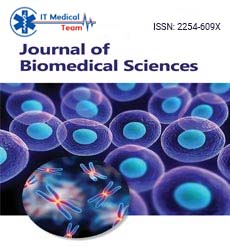Commentary - (2024) Volume 13, Issue 6
Tissue Engineering: Innovations in Artificial Organs
Bongekile Ngobese*
Department of Biomedical Sciences, University of Stellenbosch, Stellenbosch, South Africa
*Correspondence:
Bongekile Ngobese, Department of Biomedical Sciences, University of Stellenbosch, Stellenbosch,
South Africa,
Email:
Received: 19-Nov-2024, Manuscript No. IPJBS-24-15321;
Editor assigned: 22-Nov-2024, Pre QC No. IPJBS-24-15321 (PQ) ;
Reviewed: 06-Dec-2024, QC No. IPJBS-24-15321;
Revised: 17-Dec-2024, Manuscript No. IPJBS-24-15321 (R);
Published:
24-Dec-2024
Description
Tissue engineering is an interdisciplinary field that combines
biology, materials science, and engineering to create artificial
organs and tissues that can replace or enhance the function of
natural tissues. This innovative approach has the potential to
address the growing shortage of donor organs, improve
regenerative medicine, and revolutionize treatments for various
diseases. This article explores the key advancements in tissue
engineering, the technologies involved, and the future prospects
for artificial organs.
Understanding tissue engineering
At its core, tissue engineering aims to develop biological
substitutes that restore, maintain, or improve the function of
damaged tissues or organs. This process typically involves three
essential components: Scaffolds, cells, and signaling molecules.
Scaffolds serve as a temporary support structure for cells to
grow and organize into functional tissue. They can be made from
natural or synthetic materials and are designed to mimic the
properties of the target tissue. Cells, which can be derived from
various sources, including stem cells and differentiated cells, are
seeded onto these scaffolds. Finally, signaling molecules, such as
growth factors, guide the cells' behavior and development.
Innovations in artificial organs
Bioengineered organs: Recent advancements in bioengineering
have led to the development of fully functional bioengineered
organs, such as the bladder, trachea, and skin. One notable
success story is the bioengineered bladder, created using a
patient's own cells. This organ was grown on a biodegradable
scaffold and implanted into the patient, resulting in a successful
regeneration of bladder function. Such innovations illustrate the
potential of tissue engineering to provide personalized solutions
for patients with organ failure.
3D bioprinting: 3D bioprinting is a revolutionary technique
that allows for the precise layering of cells and biomaterials to
create complex tissue structures. By utilizing Computer-Aided
Design (CAD) software, researchers can design intricate scaffolds
that replicate the architecture of natural tissues. This technology
enables the production of customizable organs tailored to
individual patients, enhancing compatibility and reducing the risk of rejection. Several research groups are actively exploring
the potential of 3D bio printing to create various tissues,
including heart valves, liver tissues, and even whole organs.
Organ-on-a-chip technology: Organ-on-a-chip technology is a
novel approach that allows researchers to create miniature
models of human organs on microfluidic chips. These devices
contain living cells and tissues, mimicking the physiological
environment of actual organs. This technology offers a platform
for studying disease mechanisms, drug responses, and
toxicology in a controlled setting. Organ-on-a-chip models have
shown promise in drug testing, potentially reducing the reliance
on animal models and accelerating the development of new
therapies.
Stem cell applications: Stem cells play a critical role in tissue
engineering due to their unique ability to differentiate into
various cell types. Researchers are investigating the use of
induced Pluripotent Stem Cells (iPSCs) and Mesenchymal Stem
Cells (MSCs) for generating tissues and organs. iPSCs can be
derived from a patient's own cells, minimizing the risk of
immune rejection. Recent studies have demonstrated the
successful differentiation of iPSCs into functional neurons,
cardiomyocytes, and pancreatic beta cells, paving the way for
advancements in treating neurodegenerative diseases, heart
disorders, and diabetes.
Challenges and ethical considerations
Despite the promising advancements in tissue engineering,
several challenges remain. One significant hurdle is the
vascularization of engineered tissues. For artificial organs to
function effectively, they require an adequate blood supply to
deliver nutrients and remove waste products. Researchers are
actively exploring strategies to promote vascularization within
engineered tissues, including incorporating endothelial cells into
scaffolds and utilizing growth factors to stimulate blood vessel
formation.
Ethical considerations also arise in the field of tissue
engineering, particularly concerning the use of stem cells. The
sourcing of embryonic stem cells raises moral questions, leading
to the exploration of alternative sources, such as adult stem cells
and iPSCs. Additionally, as technology advances, issues related to
organ transplantation, ownership, and commercialization of
bioengineered organs need to be carefully addressed to ensure ethical practices in this rapidly evolving field.
Tissue engineering represents a groundbreaking approach to
addressing the limitations of traditional organ transplantation
and regenerative medicine. Innovations in bioengineered organs,
3D bioprinting, organ-on-a-chip technology, and stem cell
applications have paved the way for remarkable advancements in this field. While challenges and ethical considerations remain,
the future of tissue engineering holds great promise for
enhancing the quality of life for individuals with organ failure
and other debilitating conditions. As research continues to
progress, the vision of personalized, functional artificial organs
may soon become a reality, revolutionizing the landscape of
modern medicine.
Citation: Ngobese B (2024) Tissue Engineering: Innovations in Artificial Organs. J Biomed Sci Vol:13 No:6





